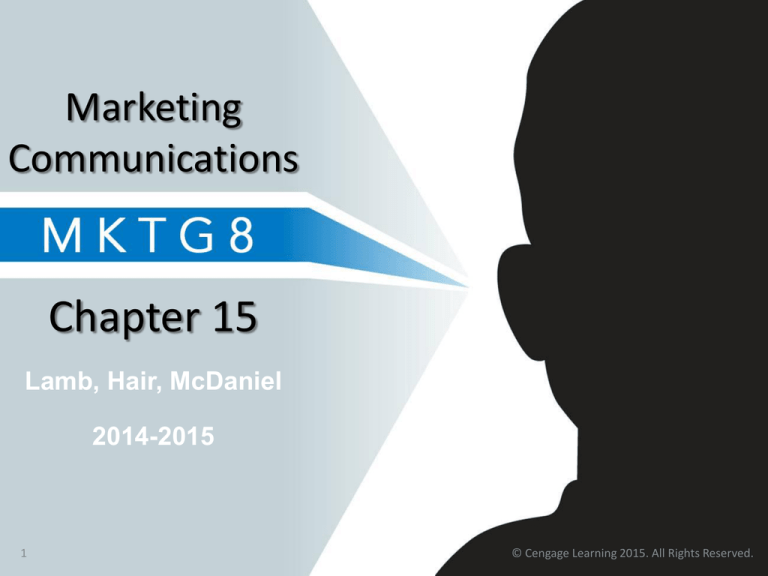
Marketing
Communications
Chapter 15
Lamb, Hair, McDaniel
2014-2015
1
© Cengage Learning 2015. All Rights Reserved.
• Discuss the role of promotion in the marketing
mix
• Describe the communication process
• Explain the goal and tasks of promotion
• Discuss the elements of the promotional mix
• Discuss the AIDA concept and its relationship to
the promotional mix
• Discuss the concept of integrated marketing
communications
• Describe the factors that affect the promotional
mix
© 2015 by Cengage Learning Inc. All Rights Reserved.
2
The Role of Promotion
Promotional Strategy
A plan for the optimal use of the elements of
promotion:
Advertising
Public Relations
Personal Selling
Sales Promotion
Social Media
1
© 2015 by Cengage Learning Inc. All Rights Reserved.
3
Exhibit 15.1
Role of Promotion in the Marketing Mix
1
4
© 2015 by Cengage Learning Inc. All Rights Reserved.
Goals and Tasks of Promotion
Informing
Reminding
Target
Audience
Connecting
Persuading
3
© 2015 by Cengage Learning Inc. All Rights Reserved.
5
Goals of Promotion
The ultimate goal of promotion is to create
competitive advantage. The tasks are as
follows.
• Informing: Increase awareness, Explain how product
works, Suggest new uses, Build company image
• Reminding: Remind customers about its need, Remind
customers where to buy product, Maintain customer
awareness
• Persuading: Encourage brand switching, Change
customers’ perceptions of product attributes, Influence
immediate buying decision, Persuade customers to call
• Connecting: Form relationships through social media,
Encourage transparent information exchange, Customers
become brand advocates
Competitive Advantage
High product quality
Rapid delivery
Low prices
Excellent service
Unique features
1
© 2015 by Cengage Learning Inc. All Rights Reserved.
7
Exhibit 15.2
Communication Process
2
8
© 2015 by Cengage Learning Inc. All Rights Reserved.
Exhibit 15.1
Role of Promotion in the Marketing Mix
1
9
© 2015 by Cengage Learning Inc. All Rights Reserved.
Advertising
Most commonly distributed by
traditional media, though
increasingly through nontraditional media, such as Web
sites, e-mail, blogs, and
interactive video kiosks in malls
and supermarkets.
4
© 2015 by Cengage Learning Inc. All Rights Reserved.
10
Public Relations
Evaluates public attitudes, identifies
areas within the organization that
public may be interested in, and
executes a program to earn public
understanding.
4
© 2015 by Cengage Learning Inc. All Rights Reserved.
11
Sales Promotion
Marketing activities—other than
personal selling, advertising, and
public relations—that stimulate
consumer buying and dealer
effectiveness.
4
© 2015 by Cengage Learning Inc. All Rights Reserved.
12
Personal Selling
Planned presentation to one or
more prospective buyers for the
purpose of making a sale.
4
© 2015 by Cengage Learning Inc. All Rights Reserved.
13
Social Media
Promotion tools used to
facilitate conversations
among people online.
4
© 2015 by Cengage Learning Inc. All Rights Reserved.
14
Exhibit 15.3
Digital Media Types
Owned Media
• Websites
• Blogs
• Social Media Presence
Paid Media
• Banner ads
• Sponsored posts
Social Media is
concentrated here, between
owned and earned media,
with some (but not much)
paid media depending on
the strategy.
Earned Media
• Media Coverage
• SEO
• Publicity
activities
4
© 2015 by Cengage Learning Inc. All Rights Reserved.
15
Exhibit 15.4
Characteristics of the Elements in the
Promotional Mix
© 2015 by Cengage Learning Inc. All Rights Reserved.
16
The AIDA Concept
Attention
Interest
Desire
Action
5
Model that outlines the process for
achieving promotional goals in
terms of stages of consumer
involvement with the message.
© 2015 by Cengage Learning Inc. All Rights Reserved.
17
The AIDA Concept
Action
Desire
Interest
Attention
Conative (doing)
Affective (feeling)
Cognitive (thinking)
5
© 2015 by Cengage Learning Inc. All Rights Reserved.
18
Exhibit 15.5
The Promotional Mix and AIDA
Attention
Interest
Desire
Action
Advertising
Public
Relations
Sales
Promotion
Personal
Selling
Social Media
5
Very Effective
Somewhat Effective
© 2015 by Cengage Learning Inc. All Rights Reserved.
Not Effective
19
Integrated Marketing
Communications
The careful coordination of
all promotional messages to
assure the consistency of
messages at every contact
point where a company
meets the consumer.
6
© 2015 by Cengage Learning Inc. All Rights Reserved.
20
IMC Popularity Growth
• Proliferation of thousands of media
choices.
• Fragmentation of the mass market.
• Slash of advertising spending in favor of
promotional techniques that generate
immediate response.
6
© 2015 by Cengage Learning Inc. All Rights Reserved.
21
Factors Affecting the
Choice of Promotional Mix
Nature of the product
Stage in PLC
Target market characteristics
Type of buying decision
Promotion funds
Push or pull strategy
7
© 2015 by Cengage Learning Inc. All Rights Reserved.
22
Exhibit 15.6
Product Life Cycle and the Promotional Mix
Light
Advertising;
Preintroduction
publicity
Heavy
Advertising;
PR for
awareness;
sales
promotion
for trial
Advertising,
PR, brand
loyalty;
personal
selling for
distribution
Ads
decrease;
sales
promotion;
personal
selling;
reminder &
persuasive
© 2015 by Cengage Learning Inc. All Rights Reserved.
AD/PR
decrease;
limited sales
promotion;
personal
selling for
distribution
23
Goals and Tasks
of Promotion
Informing
Reminding
PLC Stages:
PLC Stages:
Introduction
Early Growth
Maturity
Target
Audience
PLC Stages:
PLC Stages:
Growth
Maturity
All
Connecting
Persuading
3
© 2015 by Cengage Learning Inc. All Rights Reserved.
24
Exhibit 15.7
Push Strategy versus Pull Strategy
7
© 2015 by Cengage Learning Inc. All Rights Reserved.
25
Ch 15 Discussion Questions
1.
2.
3.
4.
5.
6.
What is Promotional Mix? Discuss the Elements of the
Promotional Mix.
What is Promotional Mix? Explain goals and tasks of
promotional mix in marketing.
Describe the Communication Process. Why a marketer
should study the communication process?
Explain the AIDA concept/model and its relationship to
the promotional mix.
Discuss the Factors Affecting the Choice of Promotional
Mix.
Explain how the promotion changes at various stages of
the Product Life Cycle.




